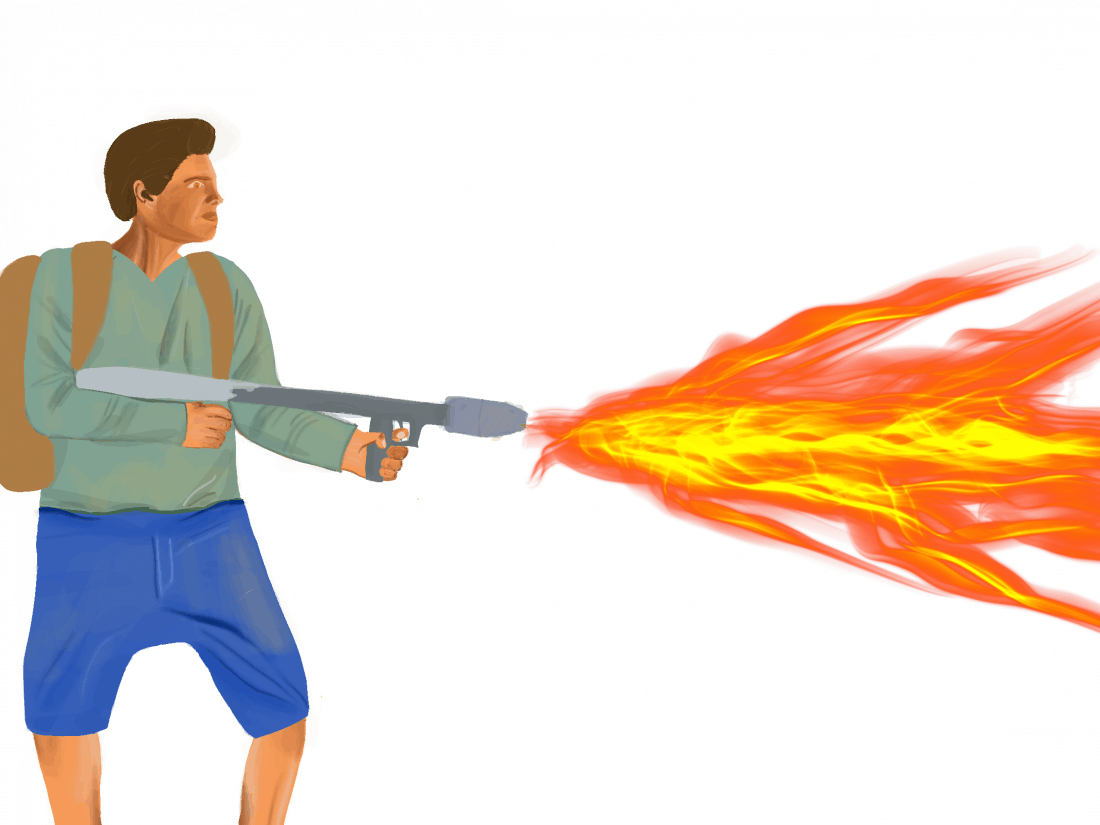
It’s not every day you find yourself cracking up at a murder scene or laughing as someone is barbequed with a flamethrower. Yet here we are — living in Quentin Tarantino’s gruesome, over-the-top and violent dream world.
Director, writer and actor Quentin Tarantino has always been shrouded in controversy. There has been much debate on the abundance of racial slurs in Tarantino’s films and the necessity of intensely graphic violence which has become commonplace in his films.
This has not stifled his popularity, however. Despite being in the movie industry since the late 1980s, his career as a filmmaker didn’t take off until the release of his first feature-length film in the 1992 bloody heist thriller Reservoir Dogs. Since then, he has made 10 more films, each maintaining his stylistic calling-card of exaggerated, gory violence.
Violence makes most of Tarantino’s films hard to watch. As loved as Inglourious Basterds is, watching Aldo Raine meticulously carve a swastika into the forehead of Hans Landa is enough to turn the stomachs of every audience member.
Violence is not hidden or downplayed in his films — it’s up close, it’s personal and it’s gross. But the drama overkill is not to desensitize the audience to real-world violence.
When asked about the use of violence in his films by Newsday in a 1994 press conference, Tarantino responded, “If you ask me how I feel about violence in real life, well, I have a lot of feelings about it. It’s one of the worst aspects of America. In movies, violence is cool. I like it.”
While not condoning violence in real life, Tarantino uses violence in his films as an aesthetic device to manipulate the audience’s emotions through heavy exaggeration.
Take Tarantino’s 1994 film Pulp Fiction for example. At first, the audience is taken aback at the sudden, gruesome death of Marvin when Vincent accidentally shoots him in the head. The weight of the graphic, accidental murder immediately subsides as Vincent sighs in an oh-so casual tone, “Ah man, I shot Marvin in the face.”
While poor Marvin’s death is horrifically violent — we’re talking bright, red blood splatterred all over the back seat of a white car — the treatment of the scene shifts the audience’s shock to laughter.
The casual humour associated with Tarantino’s overexaggerated gore further suggests that violence in his films is not meant to be taken at face value.
One of the vehicles Tarantino uses in depicting violence to elicit emotion in the viewer is the classic cinematic trope of a quest for revenge. This trope is popular with audiences as most can identify with a character that is motivated by a desire for revenge.
Tarantino stacks the deck by the frequent use of villains which audiences are predisposed to dislike, such as Nazis, the KKK and the Manson family. The audience is left with little choice but to side with Tarantino’s protagonists, even if both sides are performing violent deeds.
She may be an ex-assassin, but you root for the Bride in Kill Bill as she slices and dices her way to get revenge on Bill. In Django Unchained, the audience can’t help but cheer for ex-slave Django as he strives to save his wife, despite his quest to rescue her culminating in a bloody massacre.
Most recently, when Once Upon a Time in Hollywood’s Rick Dalton runs from the Manson girl in his pool like she’s the killer in a 70s slasher movie who just won’t die, it’s hard not to be amused. The perfectly timed set up of Rick’s flamethrower allows the audience just enough time for a guilty chuckle before the incineration of the half-dead Manson girl.
For some audiences, the violence in Tarantino films — while dramatically over-the-top — is still too brutal to watch. But there is a method to his madness as meaning can be found in the violence beyond just being seen as ‘cool.’
In a 2010 interview with The Telegraph, Tarantino said, “I feel like I’m an orchestra conductor and the audience are my instruments. So it’s like, ‘Laugh, laugh… Now be horrified…’ That’s what I get off on. When a film does that to me, I know I’ve had a good time at the cinema.”
Tarantino’s use of violence easily sways the audience, appealing to feelings — be they of horror or humour — rather than logic and rationale. For a few fleeting moments, the audience can become one with Tarantino’s protagonists and feel the same sense of satisfaction and gratification when the villains get their just deserts.
This trademark of gruesome, cartoonish and cinematic style of violence leaves the audience with conflicted feelings of abject horror and catharsis. Despite the graphic violence, Tarantino’s films are captivating, passionately done and brilliantly written. I mean, there’s a reason we keep watching Tarantino films, right?
—
Vici Herbison
Graphic: Nykole King/ Editor-in-Chief